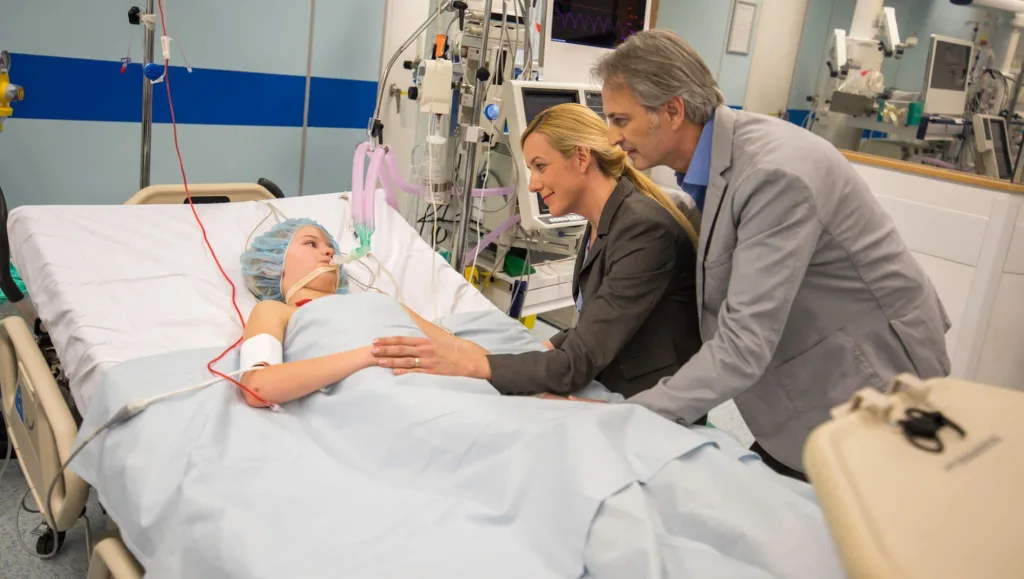No longer are loved ones limited in contact with critically ill patients.
More than 5.7 million patients are admitted annually to intensive care units in the U.S., according to SCCM.org. Families' roles in the intensive care unit have changed dramatically in recent years to a more hands-on approach. [caption id="attachment_51929" align="alignleft" width="250"] Ruth Kleinpell, RN[/caption] "Fifteen years ago, we used to think ICU patients needed quiet and rest," said Ruth Kleinpell, PhD, RN-CS, FCCM, president of the Society of Critical Care Medicine. "We limited visiting hours, so that they could rest. Now we know the benefits of having families not only present, but involved in care in the ICU, in terms of helping patients with recovery, preventing delirium, and helping with a plan of care and with decision making." Priscilla Gazarian, PhD, RN, remembers working as an ICU nurse about 20 years ago when families had to call and request permission to visit their loved ones. "That presented all kinds of problems: emotional distress and PTSD for the care partners and patients," said Gazarian, who today is a nurse scientist at Brigham and Women's Hospital and associate professor at the School of Nursing and Health Sciences, University of Massachusetts, Boston. "This idea that we're going to somehow shield the families from what's going on, wait until we've taken care of the patient and then call the family in, really denies the family a deep understanding of the patient's condition and acceptance of the situation," Gazarian continued. [caption id="attachment_51931" align="alignright" width="282"]
Ruth Kleinpell, RN[/caption] "Fifteen years ago, we used to think ICU patients needed quiet and rest," said Ruth Kleinpell, PhD, RN-CS, FCCM, president of the Society of Critical Care Medicine. "We limited visiting hours, so that they could rest. Now we know the benefits of having families not only present, but involved in care in the ICU, in terms of helping patients with recovery, preventing delirium, and helping with a plan of care and with decision making." Priscilla Gazarian, PhD, RN, remembers working as an ICU nurse about 20 years ago when families had to call and request permission to visit their loved ones. "That presented all kinds of problems: emotional distress and PTSD for the care partners and patients," said Gazarian, who today is a nurse scientist at Brigham and Women's Hospital and associate professor at the School of Nursing and Health Sciences, University of Massachusetts, Boston. "This idea that we're going to somehow shield the families from what's going on, wait until we've taken care of the patient and then call the family in, really denies the family a deep understanding of the patient's condition and acceptance of the situation," Gazarian continued. [caption id="attachment_51931" align="alignright" width="282"] Priscilla Gazarian, RN[/caption] But today, the focus is on open visitation and involving patients more in care, said Kleinpell, a professor at Vanderbilt School of Nursing in Nashville, Tenn. and Rush University College of Nursing in Chicago. Although some ICUs still have policies preventing families from moving freely in and out of the units, many hospitals embrace family involvement.
Priscilla Gazarian, RN[/caption] But today, the focus is on open visitation and involving patients more in care, said Kleinpell, a professor at Vanderbilt School of Nursing in Nashville, Tenn. and Rush University College of Nursing in Chicago. Although some ICUs still have policies preventing families from moving freely in and out of the units, many hospitals embrace family involvement.
"Some hospitals have implemented family-centered rounds, where families listen in on medical rounds, so they can hear the discussion and decision making that goes into care," Kleinpell said.
"Some ICUs have integrated patient advisory boards, so that former patients give feedback on unit-based initiatives. There are others that have instituted patient diaries to help patients remember their time in the ICU," she continued. Even ways in which hospitals are designed have changed. Today, more ICUs feature single-room units, with beds for patients' loved ones. Waiting rooms might offer special amenities for families, including kitchens, according to Kleinpell.
Evidence-based support
Abundant evidence exists that families play an important role in optimal ICU care. In January 2017, the Society of Critical Care Medicine released the updated Guidelines for Family-Centered Care in the Neonatal, Pediatric and Adult ICU, which identifies best practices for family-centered ICU care. Kleinpell works as co-principal investigator on a national family-centered care collaborative in which 63 ICU teams came together and implemented an initiative of their choosing over a 10-month period. "Some chose to use open visitation, some chose patient-centered rounds, etc.," Kleinpell said. Collaborative members shared initiative ideas, barriers and challenges during a series of monthly calls and webinars, then implement the initiatives. "We're just finishing the final data collection, but it was very beneficial for the teams to go through the process together and get feedback," Kleinpell said. [caption id="attachment_51932" align="alignleft" width="250"] Kumiko Schnock, RN[/caption] In other research, a task force of four large university teaching hospitals developed a format for basic educational content in a digital learning center for ICU patients and families. The format was highlighted in the study, "Identifying Information Resources for Patients in the Intensive Care Unit and Their Families," published in the December 2017 issue of Critical Care Nurse. The study suggested unclear, uncoordinated and inconsistent communication and information are major sources of stress for ICU patients and families. And although a digital learning center won't replace the need for face-to-face communication, it helps to centralize basic information, making it more easily accessible, according to Gazarian, the study's senior author. Lead author of the study, Kumiko O. Schnock, PhD, RN, a nurse scientist at Brigham and Women's Hospital, said researchers have developed an information pathway structure that supports patient information needs during their stay in the ICU. The next step, Schnock said, is to create various platforms for the information, such as a phone app and a website.
Kumiko Schnock, RN[/caption] In other research, a task force of four large university teaching hospitals developed a format for basic educational content in a digital learning center for ICU patients and families. The format was highlighted in the study, "Identifying Information Resources for Patients in the Intensive Care Unit and Their Families," published in the December 2017 issue of Critical Care Nurse. The study suggested unclear, uncoordinated and inconsistent communication and information are major sources of stress for ICU patients and families. And although a digital learning center won't replace the need for face-to-face communication, it helps to centralize basic information, making it more easily accessible, according to Gazarian, the study's senior author. Lead author of the study, Kumiko O. Schnock, PhD, RN, a nurse scientist at Brigham and Women's Hospital, said researchers have developed an information pathway structure that supports patient information needs during their stay in the ICU. The next step, Schnock said, is to create various platforms for the information, such as a phone app and a website.
"We would like to create a free database that ICU patients and families can use," Schnock said.
In a study published last year in AACN Advanced Critical Care, researchers examined relationships in the ICU work environment, patient acuity, nurse workflow and attitudes toward family engagement. Lead author Breanna Hetland, PhD, RN, CCRN-K, assistant professor in the College of Nursing, University of Nebraska Medical Center, said the takeaway for nurses is patient and family engagement is quickly becoming a necessary component to providing high quality ICU care. But gaps in knowledge remain. [caption id="attachment_51933" align="alignright" width="250"] Breanna Hetland, RN[/caption] Critical care nurses have limited evidence-based strategies, policies or guidelines to address certain questions regarding family-centered care, Hetland wrote in an email to Nurse.com. Among those questions: Which caregivers should be involved? How much should they be involved? What types of care is safe for each individual caregiver to perform, how will care performed by families be communicated to the RN or recorded into the EMR? "With recent funding from [the American Association of Critical-Care Nurses] for my project titled, 'Evaluation of a Web-Based Intervention to Promote Family Caregiver Engagement in Symptom Assessment and Management during Mechanical Ventilation,' we aim to enable researchers and clinicians to work collaboratively to better understand the psychophysiological factors that influence attitudes towards 'engagement' and develop a tailored intervention that effectively promotes patient and family involvement in the provision of care in the ICU," Hetland said in the email.
Breanna Hetland, RN[/caption] Critical care nurses have limited evidence-based strategies, policies or guidelines to address certain questions regarding family-centered care, Hetland wrote in an email to Nurse.com. Among those questions: Which caregivers should be involved? How much should they be involved? What types of care is safe for each individual caregiver to perform, how will care performed by families be communicated to the RN or recorded into the EMR? "With recent funding from [the American Association of Critical-Care Nurses] for my project titled, 'Evaluation of a Web-Based Intervention to Promote Family Caregiver Engagement in Symptom Assessment and Management during Mechanical Ventilation,' we aim to enable researchers and clinicians to work collaboratively to better understand the psychophysiological factors that influence attitudes towards 'engagement' and develop a tailored intervention that effectively promotes patient and family involvement in the provision of care in the ICU," Hetland said in the email.
Challenges remain
Challenges to integrating families into ICU care remain.
"Every hospital has its own challenges -- especially when they're trying to implement large clinical initiatives, such as families on rounds or open visitation," Kleinpell said. "And often clinicians are resistant at first because there's the perception that families will be in the way and families will cause them more time-consuming explanations, if they're around more. In actuality, it's the opposite."
Studies have shown having family involvement saves clinicians time later on when it comes time to having family-care conferences because families are more knowledgeable. And there's more trust built up between families and clinicians, Kleinpell said. Of course, there have to be ground rules and guidelines in place to address escalating family disagreements and other family dynamics, according to Kleinpell. "Patient, as well as staff safety, is always a priority," she said.
Nurses are key
Nurses are in key positions to promote family-centered care, while advocating for patients and being proactive about family engagement in the ICU, Kleinpell said. "When they hear of clinicians being resistant to change, [it's important] to identify the evidence-based practice," Kleinpell said. "The changes are really required because they're meant to help the ICU patient's recovery. It used to be said that families were visitors in ICU, but we're visitors in our patients' and families' lives, so we need to promote optimal care and healing, and that includes involving the families."
Don't miss our new Critical Care Nursing Trends You Should Know digital edition for the latest stories, insights and challenges in the specialty.
Courses Related to 'Critical Care Nursing'
CE159-60: Administration of Moderate Sedation/Analgesia (1 contact hr) To effectively and safely participate in the administration of IV moderate sedation, RNs must be able to differentiate between the levels of sedation/analgesia; demonstrate competence with preprocedural, procedural and postprocedural nursing care; anticipate and respond to patient emergencies during sedation; and understand the medical-legal aspects of sedation/analgesia. This module will address and define the various levels of sedation, the care of patients through the continuum of care associated with moderate sedation and the appropriate medications to achieve moderate sedation. CE723: Common Brain Injuries and the CT Scan (1 contact hr) Most healthcare workers have difficulty understanding CT scans of the brain. This is most likely related to the complexity of the brain's anatomy. Understanding the cross-sectional anatomy of the normal, injured or diseased brain can help improve awareness of common brain injuries that can be diagnosed with a CT scan. CE403-60: Drowning From the Inside Out (1 contact hr) Acute pulmonary edema develops rapidly with a dramatic clinical picture. Air hunger develops along with tachypnea and a productive cough with copious pink, frothy sputum, leading to an impending sense of doom and panic. Often the bubbling \\"wet\\" secretions, combined with labored breathing that inadequately satisfies the demand for air, leave the patient feeling as if he or she is \\"drowning from the inside out.\\" To compensate, the patient prefers an upright position and uses accessory muscles to assist respiration. The patient is clearly in acute distress, and needs the sharpest assessment, diagnostic, and treatment skills the ED has to offer. Despite new diagnostic and treatment options, the ED nurse must rely on basic physical assessment skills to detect subtle changes that can suggest a worsening clinical picture or a suboptimal response to therapy.






